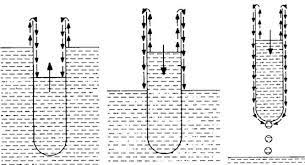A signature effect associated with superfluidity in liquid helium is that it can climb up the walls of a container and empty the container. This is seen in the video below (beginning at 1:10).
But what is the physics behind this?
Why is this a signature of superfluidity?
The schematic below is helpful. [It is figure 1.8 in Superfluidity and Superconductivity by Tilley and Tilley.]
We need to distinguish between which parts of the underlying physics occur for all fluids and which only occur for a superfluid.
1. For any liquid in thermodynamic equilibrium inside a container there is some vapour present. Some of this vapour condenses onto the surface of the container, forming a thin film of liquid on the surface. The surface of the liquid is actually not completely flat but curves upwards at the edge of the container surface. An example of this is a concave meniscus that one sees inside a small tube.
2. For a normal fluid the surface film is relatively thin and is pinned to the container surface by the viscosity of the fluid.
3. In superfluid helium the film is thick enough that the superfluid component of the fluid can flow freely. The film also extends to the top of the container walls.
Thus, the superfluid forms a continuous film that extends up and over the container walls.
4. Superfluid in the film can flow freely if there is a driving force. The difference in gravitational potential energy between the surfaces of the liquid inside and outside the container provides such a driving force. The physics of this is identical to that of a regular siphon. It is just that in the case of superfluid helium the "tube" is the surface film and that due to superfluidity this film can flow.
And so, that is why superfluids are creepy.






Why is the first sentence of point 3 true? Is the film particularly thick for He? (If so why?) How thick does it need to be for a superflow? Does the surface (material, quality/disorder) matter as in thin superconductors?
ReplyDelete